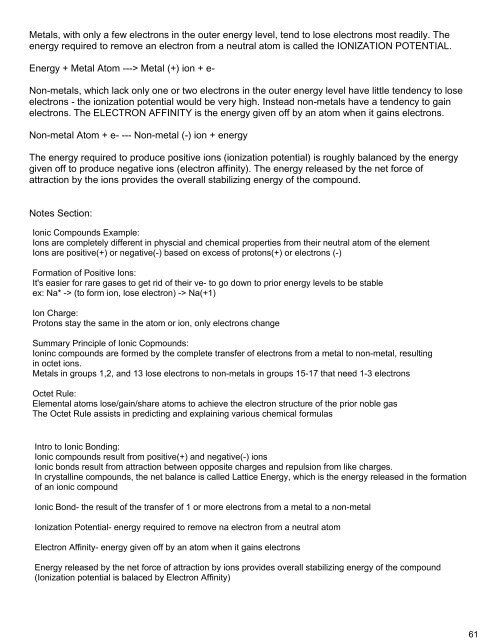(FINAL) Chemistry Notebook 2016-17
- No tags were found...
You also want an ePaper? Increase the reach of your titles
YUMPU automatically turns print PDFs into web optimized ePapers that Google loves.
61<br />
Metals, with only a few electrons in the outer energy level, tend to lose electrons most readily. The<br />
energy required to remove an electron from a neutral atom is called the IONIZATION POTENTIAL.<br />
Energy + Metal Atom ---> Metal (+) ion + e-<br />
Non-metals, which lack only one or two electrons in the outer energy level have little tendency to lose<br />
electrons - the ionization potential would be very high. Instead non-metals have a tendency to gain<br />
electrons. The ELECTRON AFFINITY is the energy given off by an atom when it gains electrons.<br />
Non-metal Atom + e- --- Non-metal (-) ion + energy<br />
The energy required to produce positive ions (ionization potential) is roughly balanced by the energy<br />
given off to produce negative ions (electron affinity). The energy released by the net force of<br />
attraction by the ions provides the overall stabilizing energy of the compound.<br />
Notes Section:<br />
Ionic Compounds Example:<br />
Ions are completely different in physcial and chemical properties from their neutral atom of the element<br />
Ions are positive(+) or negative(-) based on excess of protons(+) or electrons (-)<br />
Formation of Positive Ions:<br />
It's easier for rare gases to get rid of their ve- to go down to prior energy levels to be stable<br />
ex: Na* -> (to form ion, lose electron) -> Na(+1)<br />
Ion Charge:<br />
Protons stay the same in the atom or ion, only electrons change<br />
Summary Principle of Ionic Copmounds:<br />
Ioninc compounds are formed by the complete transfer of electrons from a metal to non-metal, resulting<br />
in octet ions.<br />
Metals in groups 1,2, and 13 lose electrons to non-metals in groups 15-<strong>17</strong> that need 1-3 electrons<br />
Octet Rule:<br />
Elemental atoms lose/gain/share atoms to achieve the electron structure of the prior noble gas<br />
The Octet Rule assists in predicting and explaining various chemical formulas<br />
Intro to Ionic Bonding:<br />
Ionic compounds result from positive(+) and negative(-) ions<br />
Ionic bonds result from attraction between opposite charges and repulsion from like charges.<br />
In crystalline compounds, the net balance is called Lattice Energy, which is the energy released in the formation<br />
of an ionic compound<br />
Ionic Bond- the result of the transfer of 1 or more electrons from a metal to a non-metal<br />
Ionization Potential- energy required to remove na electron from a neutral atom<br />
Electron Affinity- energy given off by an atom when it gains electrons<br />
Energy released by the net force of attraction by ions provides overall stabilizing energy of the compound<br />
(Ionization potential is balaced by Electron Affinity)





